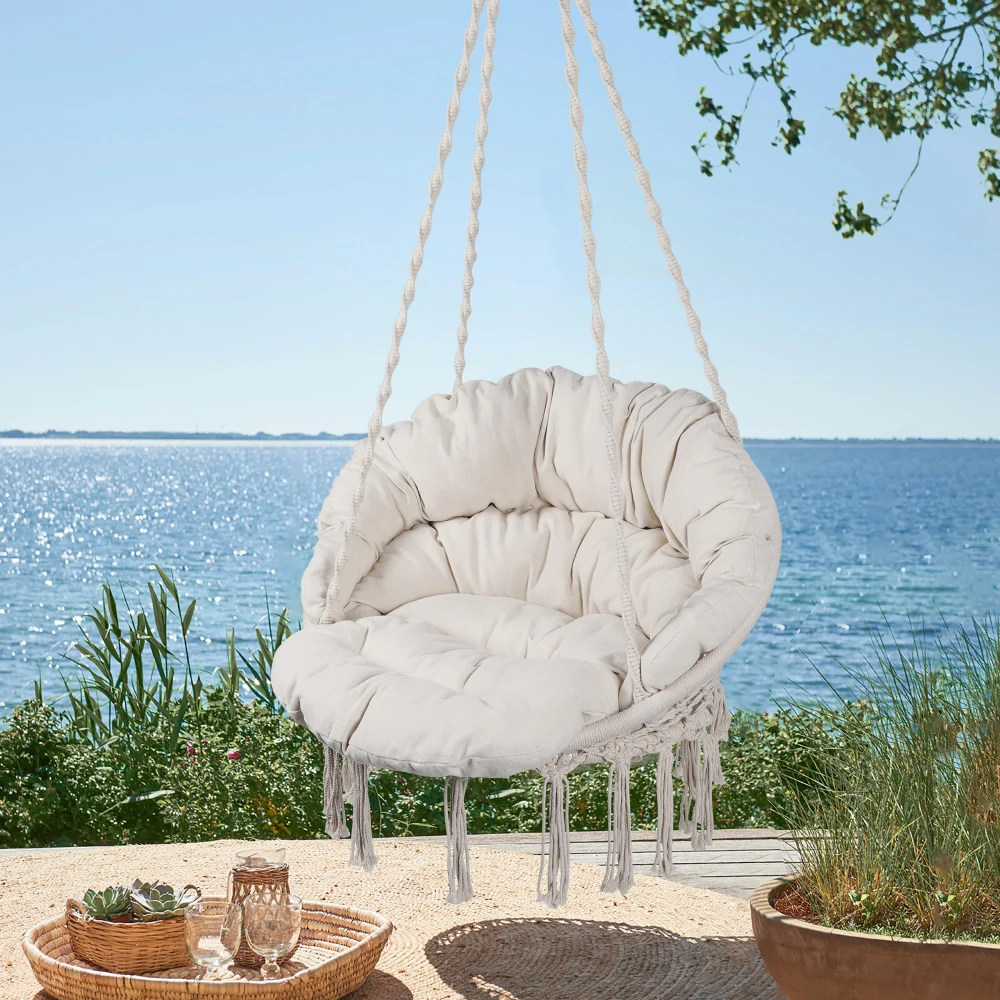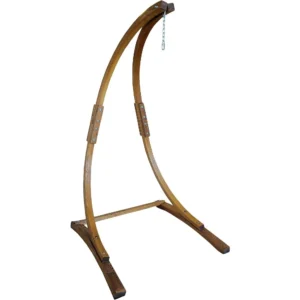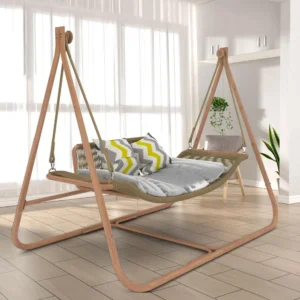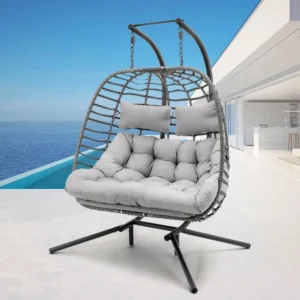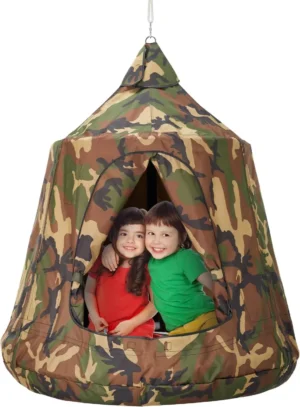1. The Perfect Blend: Understanding Porch Swing Hammocks
Porch swing hammocks represent the perfect marriage of two classic relaxation favorites – the steady support of a traditional porch swing and the cradling comfort of a hammock. This hybrid design offers the gentle swinging motion that many find so soothing while providing more structure and support than a conventional hammock. The result is a versatile relaxation spot that transforms any porch into a personal retreat from the world’s demands.
Creating a relaxation oasis on your porch isn’t just about having a place to sit – it’s about crafting a dedicated space that invites you to unwind, reflect, and rejuvenate. Porch swing hammocks excel at this by combining three essential elements: exceptional comfort that cradles your body, aesthetic appeal that enhances your outdoor space, and versatility that adapts to various porch sizes and styles. In this comprehensive guide, we’ll explore everything from the science behind their relaxing effects to selecting the perfect model for your specific needs.
The popularity of these hybrid relaxation solutions has grown substantially in recent outdoor living trends. According to recent home design surveys, outdoor living spaces have become extensions of the indoor environment, with over 70% of homeowners viewing their porch as a crucial relaxation zone. Porch swing hammocks have evolved from simple rope-and-wood constructions to sophisticated designs that blend seamlessly with both modern and traditional home exteriors, making them a centerpiece of the ultimate guide to porch swing hammocks for anyone seeking to elevate their outdoor relaxation experience.
Understanding the fundamental swing vs. hammock differences helps you appreciate why this hybrid design has become so sought-after. While traditional porch swings offer sturdy seating with back support, and classic hammocks provide that unmistakable floating sensation, swing hammocks strategically combine these benefits to create something entirely unique – a structured yet supremely comfortable relaxation station that might just become your favorite spot at home.
2. The Science of Serenity: Why Swing Hammocks Induce Relaxation
The deeply calming effect of porch swing hammocks isn’t just psychological – there’s fascinating science behind why gentle swinging motion induces such profound relaxation. Researchers at the University of Geneva discovered that the rhythmic movement similar to that experienced in a swing hammock synchronizes brain waves and helps transition the mind into pre-sleep states, making these furnishings particularly effective for unwinding after stressful days.
This natural rocking motion directly stimulates the vestibular system in your inner ear, which helps regulate balance and spatial orientation. When gently activated through swinging, this system sends signals throughout your nervous system that:
- Lower heart rate and blood pressure
- Reduce muscle tension and physical stress
- Release endorphins (natural mood elevators)
- Synchronize brain waves to patterns associated with relaxation
- Trigger childhood memories of being rocked (a universally calming experience)
Beyond the physical movement, the ergonomic design of most swing hammocks supports your body in a semi-reclined position that reduces pressure points and distributes weight evenly. Sleep specialists often recommend this position for alleviating back tension and promoting proper spinal alignment. The psychological aspect shouldn’t be overlooked either – having a designated relaxation space creates a powerful mental cue that it’s time to disconnect from responsibilities and focus on self-care. The effectiveness of swinging porch swing motion for stress relief has been documented in multiple studies, confirming what many users instinctively feel when they sink into these comfortable retreats.
3. Finding Your Perfect Match: Types of Porch Swing Hammocks
With numerous styles available, finding your ideal porch swing hammock requires understanding the unique benefits and characteristics of each type. The perfect match depends on your space constraints, aesthetic preferences, and how you plan to use your relaxation space. Let’s explore the main categories to help you identify which will create your ideal porch retreat.
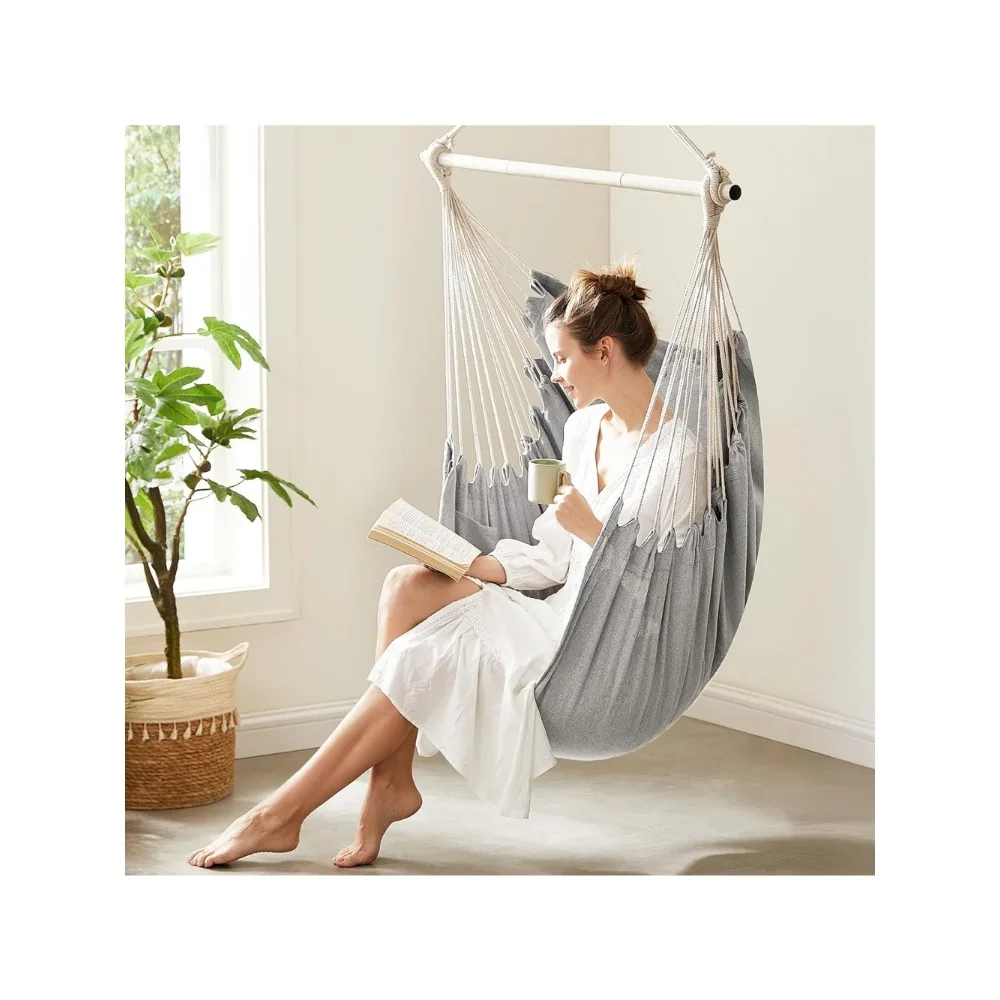
Traditional Bench-Style Porch Swings
- Classic horizontal design with supportive back and armrests
- Typically accommodates 2-3 people (250-600 lbs capacity)
- Creates a social relaxation space perfect for conversations
- Available in various materials from classic wood to modern poly lumber
- Offers traditional aesthetic that complements most architectural styles
Egg Chair Swing Hammocks
- Distinctive oval or egg-shaped design that creates a cocoon-like experience
- Single-person capacity (typically 250-350 lbs)
- Provides exceptional privacy and immersive relaxation
- Perfect for smaller porches or corner installations
- Contemporary look that serves as a striking design element
Daybed Swing Hammocks
- Full lounging capability with generous dimensions
- Supports stretching out completely or seating multiple people
- Often features canopies for shade and enhanced privacy
- Requires substantial porch space (minimum 6’ x 8’ area)
- Creates a dramatic focal point and resort-like atmosphere
Macramé Swing Chairs
- Artistic woven designs with bohemian aesthetic
- Lightweight construction (typically 200-300 lbs capacity)
- Creates airy, visually interesting texture
- Often features intricate patterns and natural materials
- Brings artistic, handcrafted element to porch décor
Freestanding Swing Hammocks
- Self-contained units with built-in support frames
- No installation or mounting required
- Can be repositioned as needed around your porch
- Ideal for rental properties or situations where drilling isn’t permitted
- Available in various styles from bench swings to egg chairs
The ultimate guide to porch hammocks can provide more detailed insights into specific hammock styles, while our collection of hammock chairs with stands offers practical solutions for those seeking maximum flexibility in placement. When selecting your perfect match, consider not just the aesthetic appeal but also the practical aspects like weight capacity, durability in your climate, and how the design complements your existing porch furniture.
4. The Perfect Placement: Assessing Your Porch Space
Finding the ideal location for your swing hammock requires careful assessment of your porch dimensions, structural integrity, and overall layout. Proper placement ensures both safety and maximum enjoyment of your relaxation zone.
Start by measuring your available porch space using these guidelines:
Total Installation Area: Measure the full footprint needed, including:
* Length of the swing hammock itself (typically 4-7 feet)
* Minimum 3 feet of clear swing path in front and behind
* At least 2 feet of clearance on either side for comfortable accessHeight Requirements: Verify ceiling height accommodates:
* The hammock or swing itself (typically 18-24 inches thick)
* Hanging hardware (chains or ropes add 1-2 feet)
* Safe swing arc (minimum 12 inches from floor at lowest point)
* Ideal mounting height (7-8 feet from floor to ceiling attachment)Structural Support Assessment:
* Locate ceiling joists or beams using a stud finder
* Ensure support can handle dynamic weight (typically 2.5x static weight capacity)
* For porches without suitable overhead support, consider freestanding modelsOptimal Placement Considerations:
* Orient toward pleasant views when possible
* Account for sun patterns throughout the day
* Create a natural flow with existing furniture
* Consider privacy from neighbors and street visibility
The perfect porch swing hammock locations will vary depending on your specific porch layout, but certain principles remain consistent. Place your swing hammock where it creates a natural focal point without obstructing traffic flow. For safety, ensure your installation point can support at least 600 pounds for single-person hammocks and 800+ pounds for multi-person models, accounting for the dynamic force created during swinging motion.
Measurement Checklist:
– □ Porch width and depth measured
– □ Ceiling height confirmed
– □ Structural support identified
– □ Swing clearance calculated
– □ Weight capacity verified
– □ View orientation considered
– □ Sun exposure evaluated
Taking the time to thoroughly assess your space before purchasing ensures you’ll select a swing hammock that fits perfectly and can be safely installed, creating a relaxation zone that’s both beautiful and functional.
5. Built for Comfort and Durability: Materials That Matter
The materials used in your porch swing hammock significantly impact both comfort and longevity, particularly since these furnishings face the challenges of outdoor exposure. Understanding the properties of different frame, fabric, and hardware options helps you make choices aligned with your climate, maintenance preferences, and aesthetic goals.
Frame Materials Comparison
| Material | Weather Resistance | Durability | Maintenance | Aesthetic |
|---|---|---|---|---|
| Teak | Excellent (natural oils) | 25+ years | Minimal; turns silver-gray if untreated | Warm, classic luxury |
| Cedar | Very Good | 15-20 years | Moderate; needs sealing every 2-3 years | Rustic, aromatic |
| Aluminum | Excellent | 20+ years | Minimal; occasional cleaning | Modern, lightweight |
| Powder-Coated Steel | Good | 10-15 years | Moderate; check for rust spots | Industrial strength |
| Poly Lumber | Excellent | 20+ years | Minimal; simple cleaning | Contemporary, colorful |
For maximum durability in challenging climates, teak and poly lumber offer exceptional performance with minimal maintenance. Cedar provides a beautiful, aromatic option but requires more regular care to maintain its appearance and structural integrity.
Fabric Selection for Comfort and Longevity
Choosing the perfect porch hammock fabric involves balancing softness against durability. High-performance outdoor fabrics like Sunbrella stand out for their exceptional combination of comfort and weather resistance, offering:
- 5+ years of color retention even in direct sunlight
- Mold and mildew resistance
- Quick-drying properties after rain
- Soft texture that remains comfortable against skin
Other quality options include solution-dyed olefin (excellent colorfastness) and treated polyester blends (good balance of comfort and value). For cushion fillings, quick-dry foam with antimicrobial treatments offers the best combination of comfort and practical outdoor performance.
Hardware Considerations
The connecting components of your swing hammock may seem minor but are critical to both safety and longevity:
- Marine-grade stainless steel chains or hardware resist rust in humid environments
- Galvanized hardware provides good protection at a lower price point
- Nylon or polyester ropes offer a softer aesthetic but require more frequent replacement
- Weight-rated carabiners and hooks provide easy seasonal installation/removal
The best materials for hammock chairs for porches typically combine weather-resistant frames with performance fabrics and quality hardware systems. For coastal locations, prioritize marine-grade components that resist salt corrosion. In areas with extreme temperature fluctuations, materials with low expansion/contraction rates (like aluminum or poly lumber) typically outperform others for long-term structural integrity.
6. Comfort Features That Elevate the Experience
What transforms a basic swing hammock into a truly exceptional relaxation experience are the thoughtful comfort features that address every aspect of physical and sensory enjoyment. When evaluating options for your porch oasis, look beyond the basic structure to these comfort-enhancing elements.
Essential Comfort Elements
- Cushioning Depth: Look for seat cushions at least 4-5 inches thick and back cushions 3-4 inches thick for optimal support
- Ergonomic Design: Seek slightly reclined back angles (10-15 degrees) that support natural spinal alignment
- Body-Conforming Features: Quilted surfaces, pillow-top padding, or subtle hammock-style curves that cradle the body
- Arm Support: Padded or contoured armrests at natural resting height (7-9 inches above seat)
- Head/Neck Support: Adjustable or removable headrests/pillows for customizable comfort
Relaxation-Enhancing Additions
Beyond basic comfort, these features significantly amplify the relaxation potential:
- Integrated Canopies: Provide shade and create a cocooning effect that enhances privacy
- Adjustable Recline: Mechanisms that allow position changes from upright socializing to laid-back lounging
- Cup Holders & Side Tables: Keep refreshments within reach without disrupting relaxation
- Storage Pockets: Convenient spots for books, devices, or personal items
- Footrests or Ottoman Options: Complete full-body comfort by supporting legs and feet
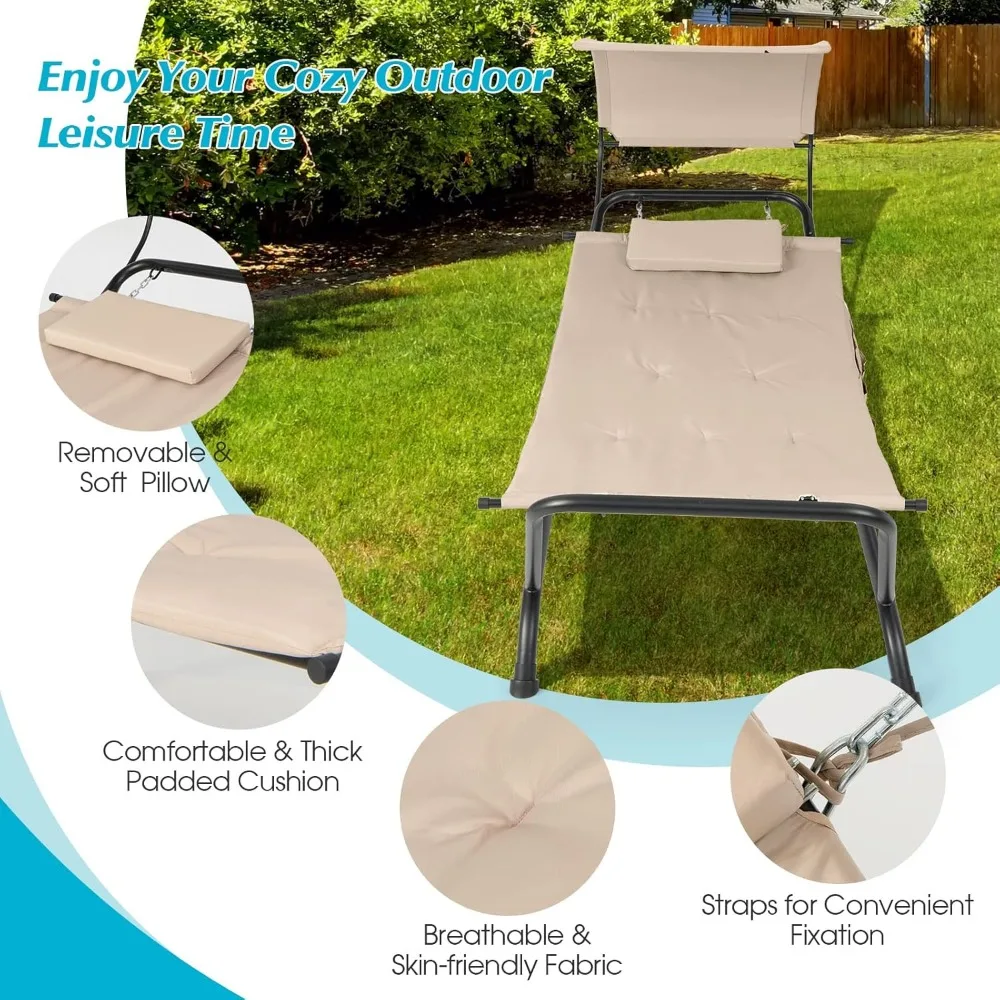
Weather Adaptation Features
The most thoughtfully designed swing hammocks include features that maintain comfort despite weather challenges:
- Quick-dry technologies that prevent soggy cushions after rain
- Breathable fabrics that stay cool in summer heat
- UV-resistant materials that remain comfortable under direct sun
- Water-repellent treatments that allow year-round enjoyment
- Removable covers for seasonal washing or replacement
Perfect porch swing hammock comfort comes from the harmonious integration of these features with your specific relaxation preferences. Some users prioritize deep cushioning for long reading sessions, while others value adjustable features that accommodate various activities. The best swing hammocks allow some degree of customization – whether through adjustable components, removable elements, or the ability to add your own accessories to create a personalized comfort experience.
7. Top-Rated Relaxing Swing Hammocks Worth Considering
After understanding the essential elements that make a porch swing hammock exceptional, let’s explore some standout options across different categories. Each selection combines comfort, durability, and thoughtful design to create a superior relaxation experience.
Best Overall for Deep Relaxation
The Serenity Daybed Swing combines the best aspects of multiple styles with these standout features:
* Generously cushioned 5-inch thickness memory foam-infused seat
* Integrated adjustable canopy for customizable shade
* Weather-resistant Sunbrella fabric that stays soft year after year
* Sturdy teak frame with mortise and tenon joinery
* 500 lb weight capacity accommodating multiple users
* Gently curved back support with ergonomic lumbar padding
Most Comfortable for Extended Lounging
The Cloud Nine Cushioned Swing excels for those who prioritize cushioning:
* Pillow-top design with multiple foam densities for pressure-point relief
* Extra-deep seat (23 inches) allows for side-lying positions
* Waterfall front edge eliminates pressure behind knees
* Plush back cushions with removable bolsters for neck support
* Quick-dry technology that prevents moisture retention
* Available in extra-wide models for spacious lounging
Best for Smaller Porches
The Compact Retreat Egg Chair maximizes comfort in limited spaces:
* Space-efficient 40” x 30” footprint fits in corners or narrow porches
* Swivel capability provides flexibility in tight spaces
* Wraparound design creates immersive relaxation experience
* All-weather wicker construction requires minimal maintenance
* Includes space-saving wall-mounting hardware option
* Folds partially for off-season storage in limited spaces
Most Versatile Design
The Adaptable Lounger stands out for its flexibility:
* Converts from upright seated position to full recline
* Modular components allow use as single chair or expanded seating
* Free-standing base requires no installation but can also be hung
* Weather-resistant aluminum frame weighs only 35 lbs for easy moving
* Accommodates accessories like side tables and canopy attachments
* Suitable for both covered and exposed porch areas
Best Weather-Resistant Option
The Elements Master swing hammock thrives in challenging environments:
* Marine-grade construction suitable for coastal conditions
* Completely rust-proof hardware and structural components
* UV-stabilized materials prevent fading for 7+ years
* High-performance fabrics resist mold, mildew and staining
* Integrated drainage system prevents water collection
* Maintains comfort in temperature extremes from 20°F to 110°F
Our porch swing chair sets collection includes many of these outstanding options with complete accessory packages for immediate enjoyment. When selecting your ideal model, prioritize the features that align with your specific relaxation preferences, available space, and local climate conditions.
Dark Wood Hammock Sets, Porch Swing Chair Sets
$653.82 Select options This product has multiple variants. The options may be chosen on the product pageA-Frame Stand Hammock Sets, Swinging Hammock Chair Sets
$154.62 Select options This product has multiple variants. The options may be chosen on the product pageLight Wood Hammock Sets, Swinging Hammock Chair Sets
$1,359.35 Select options This product has multiple variants. The options may be chosen on the product pageHammock Sets with Canopy, Heavy Duty Hammock Sets
$286.31 Select options This product has multiple variants. The options may be chosen on the product page- $963.29 Select options This product has multiple variants. The options may be chosen on the product page
Complete Camping Hammock Systems, Hanging Egg Chair Sets
$266.73 Select options This product has multiple variants. The options may be chosen on the product page
8. Installation Essentials: Setting Up Your Relaxation Station
Proper installation is critical for both the safety and enjoyment of your porch swing hammock. Following these guidelines ensures your relaxation station provides years of worry-free comfort.
Hardware Requirements for Safe Installation
- Mounting Hardware: Use only hardware specifically rated for hanging applications with clear weight capacities
- Support Hooks: S-hooks or ceiling hooks with minimum 600 lb capacity (800+ lb for multi-person models)
- Chains or Ropes: Marine-grade stainless steel chains or UV-resistant polyester ropes rated at 3x anticipated load
- Connectors: Locking carabiners or quick links with matching weight ratings
- Structural Fasteners: 3/8” or 1/2” lag bolts that penetrate at least 3 inches into solid wood support
Step-by-Step Installation Guide
Identify Structural Support
* Locate ceiling joists using a stud finder
* Mark centers of support beams for perfect alignment
* Verify supports are at least 2”x6” solid wood or equivalentPrepare Mounting Points
* Drill pilot holes sized correctly for your lag bolts
* Install ceiling hooks or eye bolts with backup plates for extra strength
* Ensure hardware is completely screwed in with no exposed threadsMeasure and Adjust Height
* Hang chains or ropes at equal lengths (typically 12-24” depending on model)
* Set height so seated position is 17-19” above floor for optimal comfort
* Check that swing will have minimum 16” clearance from walls when in motionSecure the Swing Hammock
* Attach with weight-rated connectors that allow for easy seasonal removal
* Ensure all connection points are fully closed and locked
* Verify the swing hangs level from all attachment pointsTest Before Use
* Gradually apply weight to test installation stability
* Listen for any unusual sounds that might indicate problems
* Test motion to ensure adequate clearance in all directions
How to install a porch swing hammock involves careful attention to these details, especially the weight capacity of each component in the installation chain. For ceiling installations, always mount directly into structural joists, never into decorative ceiling panels or drywall alone. When structural mounting isn’t possible, consider free-standing models that provide their own support structure.
For exceptionally heavy models or installation in older homes, professional installation may be the safest option. An experienced installer can evaluate your specific structural conditions and provide reinforcement if necessary.
9. Preserving Your Peaceful Retreat: Care and Maintenance
A well-maintained porch swing hammock not only looks better but also provides years of additional service. Implementing a regular care routine protects your investment and ensures continued relaxation without interruption.
Routine Cleaning Protocols
Different materials require specific cleaning approaches:
- Wooden Frames: Wipe with mild soap and water solution quarterly; avoid pressure washing
- Metal Components: Check for rust spots quarterly; touch up with manufacturer-recommended paint
- Fabric Surfaces: Brush off loose dirt weekly; clean spills immediately with appropriate cleaners
- Cushions: Vacuum regularly; spot clean as needed with fabric-appropriate solutions
- Wicker/Synthetic Rattan: Use soft brush attachments to clean between weaves monthly
Seasonal Care Calendar
| Season | Maintenance Tasks |
|---|---|
| Spring | Deep clean all surfaces; check and tighten hardware; apply wood preservatives if needed |
| Summer | Weekly dust removal; fabric spot cleaning; inspect chains/rope for wear |
| Fall | Clear debris from crevices; apply protective treatments before winter |
| Winter | Store removable cushions indoors; consider full cover or storage for entire unit |
Common Issues and Simple Fixes
- Squeaking: Apply silicone lubricant to chains, hooks, or moving parts
- Sagging Cushions: Fluff and rotate regularly; replace foam inserts if compression is permanent
- Fading Fabric: Apply fabric UV protectant spray seasonally; consider shade solutions
- Loose Connections: Tighten all hardware quarterly with appropriate tools
- Minor Wood Cracks: Fill with exterior wood putty and refinish affected areas
Our collection of weather-resistant hammock chairs for porches includes options specifically designed to minimize maintenance requirements while maximizing durability. For maximum longevity in challenging environments, consider models with powder-coated aluminum frames, solution-dyed acrylic fabrics, and marine-grade hardware.
Remember that preventative maintenance is always more effective than reactive repairs. A quick monthly inspection of all components allows you to catch small issues before they become significant problems, ensuring your relaxation station remains a source of joy rather than frustration.
10. Elevating Your Relaxation: Accessories and Enhancements
The right accessories can transform your porch swing hammock from simply comfortable to exceptionally luxurious. These thoughtful additions enhance functionality, comfort, and aesthetic appeal while extending usability throughout the seasons.
Comfort Enhancers
- Specialized Pillows: Neck rolls, lumbar supports, and decorative throws that add both comfort and style
- Weather-Resistant Blankets: Lightweight, quick-drying options for cooler evenings
- Seat Cushion Upgrades: Memory foam or gel-infused replacements for enhanced support
- Footrests and Ottomans: Coordinating pieces that complete the lounging experience
- Cup Holders and Side Tables: Convenient additions that keep refreshments and reading materials within reach
Weather Protection Accessories
- Water-Repellent Covers: Custom-fitted options that protect when not in use
- Attachable Canopies: Add-on shade solutions for models without built-in coverage
- Wind Guards: Side panels that reduce exposure during breezy conditions
- Heating Elements: Safe outdoor warming options to extend evening use in cooler weather
- Moisture-Wicking Seat Covers: Quick-change layers that make your swing usable shortly after rain
Ambiance Creators
- Weather-Resistant Bluetooth Speakers: Add gentle background music to enhance relaxation
- Solar-Powered String Lights: Create evening ambiance without complex wiring
- Plant Hangers: Add greenery around your relaxation zone
- Essential Oil Diffusers: Outdoor-rated aromatherapy options for multi-sensory relaxation
- Privacy Screens: Decorative panels that enhance seclusion while adding visual interest
Our hammock sets with canopy collection offers integrated solutions that combine core functionality with these enhancement features. When selecting accessories, prioritize weather-appropriate materials that match the durability of your swing hammock. Look for quick-release features that allow for easy seasonal storage of more delicate elements while maintaining the basic structure year-round.
11. Creating a Complete Relaxation Zone Around Your Swing Hammock
Your porch swing hammock can serve as the centerpiece of a thoughtfully designed relaxation zone that engages all the senses. By coordinating complementary elements, you can create an immersive retreat that feels separate from the everyday world.
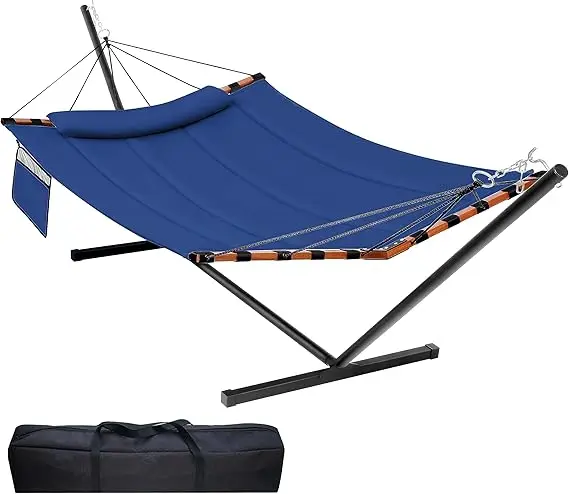
Spatial Design Concepts
- Defined Boundaries: Use outdoor rugs, planters, or decorative screens to visually separate your relaxation zone
- Balanced Layout: Position complementary furniture at comfortable conversation distances (typically 4-8 feet)
- Focal Point Orientation: Arrange elements to highlight views, garden features, or the swing itself
- Traffic Flow: Create clear pathways that don’t interrupt the peaceful feeling of the space
- Privacy Layers: Use a combination of plants, screens, and curtains for adjustable seclusion
Complementary Furnishings
Select additional pieces that enhance functionality without crowding the space:
* Small side tables within arm’s reach for drinks and books
* Compact storage options for blankets and pillows
* Low ottomans or poufs for flexible seating or footrests
* Nesting tables that can be expanded for entertaining and tucked away when not needed
Sensory Enhancement Elements
Create a multi-sensory experience by incorporating:
* Visual: Lanterns, string lights, or candles for evening ambiance
* Auditory: Wind chimes, water features, or outdoor speakers with nature sounds
* Tactile: Varied textures in cushions, throws, and floor coverings
* Olfactory: Fragrant plants like jasmine, lavender, or herbs
* Gustatory: A small beverage station or herb garden for fresh tea
Plant Selection for Peaceful Atmosphere
The right greenery enhances relaxation while providing practical benefits:
* Trailing plants like pothos or ivy for vertical interest
* Aromatic herbs like lavender or rosemary for natural fragrance
* Ornamental grasses that add movement and gentle sounds
* Compact trees like dwarf Japanese maple for filtered shade
* Low-maintenance succulents for texture without demanding care
Our comprehensive guide to ultimate relaxation with porch swing hammocks offers additional ideas for creating cohesive outdoor retreats. The most successful relaxation zones maintain a balance between openness and enclosure, stimulation and calm, allowing you to adjust elements according to your mood and the season.
12. Frequently Asked Questions About Porch Swing Hammocks
How much weight can a typical porch swing hammock hold?
Most quality porch swing hammocks support between 250-600 pounds, depending on design and materials. Single-person egg chairs typically handle 250-350 pounds, while bench-style models may support 500-600 pounds. Always check the manufacturer’s specific weight rating and add a safety margin by choosing products rated at least 20% above your anticipated maximum load. Remember that dynamic weight (swinging motion) creates more stress than static weight.
Can I install a swing hammock on any porch?
Not all porches have suitable structural support for hanging swing hammocks. Installation requires solid wooden beams or joists at least 2×6 inches in size. Decorative ceilings, thin panels, and metal frameworks generally cannot safely support swing hammocks. When structural mounting isn’t possible, consider freestanding models that include their own support frames or swinging hammock chair sets designed for independent support.
How do I protect my swing hammock during bad weather?
For short-term protection, weather-resistant covers offer the most practical solution. Look for breathable, water-repellent materials with secure fastening systems. For seasonal protection, remove cushions and store them indoors. Some swing hammock frames can remain outdoors year-round with proper protective treatment, while others should be dismounted and stored. The material of your specific model will determine the appropriate level of weather protection needed.
What’s the difference between a porch swing and a swing hammock?
Traditional porch swings typically feature rigid, bench-like seating suspended from chains or ropes, providing structured support similar to conventional furniture. Swing hammocks incorporate elements of hammock design – like curved, cradling surfaces, more flexible suspension systems, or cocoon-like enclosure – creating a more enveloping, body-conforming experience. This hybrid approach offers the security and accessibility of a swing with the exceptional comfort and relaxed posture associated with hammocks.
How do I stop my swing hammock from squeaking?
Squeaking typically occurs at connection points where metal components meet. Apply silicone-based lubricant (not WD-40) to chains, hooks, springs, or hinges. Ensure all hardware remains properly tightened, as loose components often cause noise. For rope-suspended models, inspect for fraying or weather damage that may create friction points. Wood-on-wood squeaks can be addressed with beeswax or paraffin applied to contact surfaces.
Can I leave my cushions outside year-round?
Even high-quality outdoor cushions benefit from protection when not in use. While premium materials like Sunbrella fabric resist fading and mildew, extended exposure to moisture, freezing temperatures, or intense sunlight will eventually degrade any fabric. For maximum longevity, store cushions in a dry location during extended bad weather and winter months, or use waterproof covers designed specifically for outdoor cushions. Quick-dry foam inserts significantly reduce problems associated with occasional rainfall.

